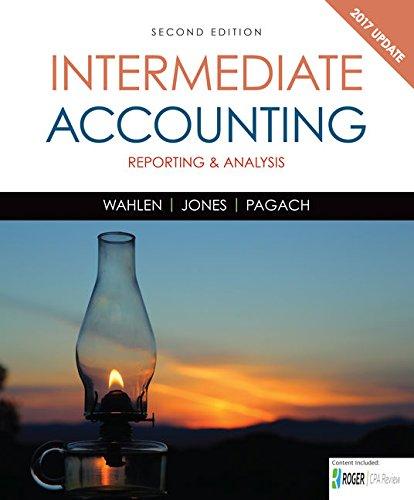
Concept explainers
1.
Ascertain the transaction price and state the manner in which the sales commission must be accounted.
1.
Explanation of Solution
Transaction price:
Transaction price is the amount of consideration that is estimated by the company to be authorized in exchange, for delivering the promised goods and services to the customer. Transaction price is examined by the seller by analyzing the terms of the contract and the normally conducts of the business
- Sales commission is capitalized as a “contract cost asset and amortized on a systematic basis consistent” with the probable pattern of transfer of the related goods or services under the contract, since the sales commission is an “incremental cost”. FASB ASC 340-40- 25-1 states that:
- “An entity shall recognize as an asset the incremental costs of obtaining a contract with a customer if the entity expects to recover those costs”.
- Only incremental must be identified as assets. “Incremental costs” of attaining a contract are those costs that would not have been incurred by the entity if the contract had not been obtained (i.e., sales commissions).
2.
Discuss if the delayed payment contract contains a significant financing contract.
2.
Explanation of Solution
Identifying a “significant financing component” in a contract needs judgment. It could be generally difficult in a long-term arrangement where a product or service delivery and cash payment takes place during the term of the contract. FASB ASC 606-10-32-19 states that:
“[W]hen adjusting the promised amount of consideration for a significant financing component, an entity shall use the discount rate that would be reflected in a separate financing transaction between the entity and its customer at contract inception. That rate would reflect the credit characteristics of the party receiving financing in the contract, as well as any collateral or security provided by the customer or the entity, including assets transferred in the contract”.
3.
Journalize entries of Company O for the year 2017.
3.
Explanation of Solution
Journal entry is a set of economic events which can be measured in monetary terms. These are recorded chronologically and systematically.
Accounting rules for Journal entries:
- To record increase balance of account: Debit assets, expenses, losses and credit liabilities, capital, revenue and gains.
- To record decrease balance of account: Credit assets, expenses, losses and debit liabilities, capital, revenue and gains.
Prepare journal entries:
| Date | Account titles and Explanation | Debit ($) | Credit ($) |
| January 2017 | 456,000 | ||
| Sales revenue (2) | 400,000 | ||
| Unearned interest | 56,000 | ||
| (To record the amount of accounts receivable) | |||
| Sales commission (3) | 20,000 | ||
| Cash | 20,000 | ||
| (To record the amount of sales commission) | |||
| December 31,2017 | Unearned interest (4) | 56,000 | |
| Interest revenue | 56,000 | ||
| (To record the amount of unearned interest) | |||
| Cash (5) | 456,000 | ||
| Accounts receivable | 456,000 | ||
| (To record the amount of cash) | |||
| Sales commission expense (3) | 20,000 | ||
| Sales commission | 20,000 | ||
| (To record the amount of sales commission expense) |
Table (1)
Working notes:
(1)Calculate the amount of accounts receivable:
(2)Calculate the amount of sales revenue:
(3)Calculate the amount of sales commission:
(4)Calculate the amount of unearned interest:
(5)Calculate the amount of cash:
4.
Journalize entries of Company P for the year 2017
4.
Explanation of Solution
Prepare journal entries:
| Date | Account titles and Explanation | Debit ($) | Credit ($) |
| January 2017 | Cash (6) | 400,000 | |
| Sales revenue | 400,000 | ||
| (To record the amount of sales revenue) | |||
| Sales commission expense (3) | 20,000 | ||
| Cash | 20,000 | ||
| (To record the sales commission expense) |
Table (2)
Working note:
(6)Calculate the amount of cash:
Want to see more full solutions like this?
Chapter 17 Solutions
Cengagenowv2, 1 Term Printed Access Card For Wahlen/jones/pagach’s Intermediate Accounting: Reporting And Analysis, 2017 Update, 2nd
 Intermediate Accounting: Reporting And AnalysisAccountingISBN:9781337788281Author:James M. Wahlen, Jefferson P. Jones, Donald PagachPublisher:Cengage Learning
Intermediate Accounting: Reporting And AnalysisAccountingISBN:9781337788281Author:James M. Wahlen, Jefferson P. Jones, Donald PagachPublisher:Cengage Learning Cornerstones of Cost Management (Cornerstones Ser...AccountingISBN:9781305970663Author:Don R. Hansen, Maryanne M. MowenPublisher:Cengage Learning
Cornerstones of Cost Management (Cornerstones Ser...AccountingISBN:9781305970663Author:Don R. Hansen, Maryanne M. MowenPublisher:Cengage Learning

